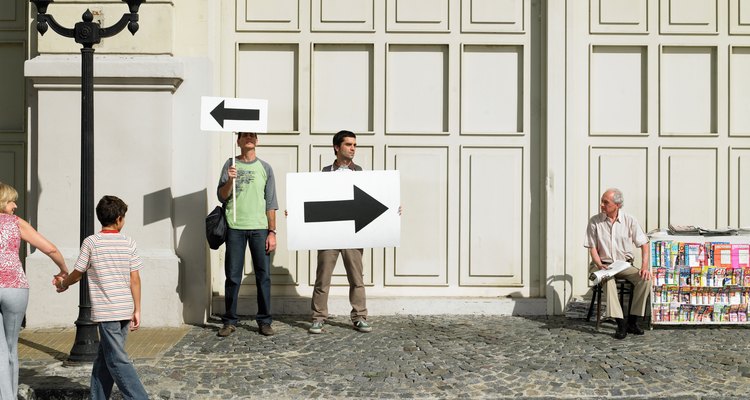
Michael Blann/DigitalVision/Getty Images
Visual messages surround us everyday. We watch real and fictional stories on television, we view advertisements in magazines and on billboards and we review charts, graphs and tables in books. We consider photographs that we want to display around our home, and we design visual aides to accompany our presentations at work.
Throughout all of these activities, we engage with and use visual communication to send and receive messages. Even though verbal communication, the ability to communicate messages through language, is often viewed as a more important or a more central type of communication, visual communication has many benefits and advantages in both personal and professional situations.
Immediacy
One of the primary benefits of visual communication over verbal is immediacy. Whether you are seeking to communicate complex information, such as with statistical information, or seeking to emphasize the importance of an idea, visual communication can often accomplish these tasks much more quickly than verbal communication.
For example, if you are seeking to illustrate decreased sales for a specific product line, you can show that information through a graph or chart and communicate the necessary information to your audience almost instantaneously. The immediacy of visual communication also allows for easy visual comparison of two or more items and the illustration of a new product line or business development. Visual communication can bring a thing, location and even idea to life in dynamic ways.
Simplicity
Another advantage to visual communication is simplicity. For example, if you seek to give driving directions to a friend, you may find it easier and even quicker to draw a visual map. Often, visual communication can simplify the information or ideas that you are seeking to pass on to another person or group of people. If you work as an engineer, you will often use diagrams along with written instructions to illustrate how a product or item works with simplicity and clarity. Visual communication can also demonstrate the relationship between two entities or ideas in accessible ways. The internal structure of an organization, for example, may be the most clearly communicated and understood through an organizational chart.
Flexibility
Visual communication can also be more flexible in many ways than verbal communication. For example, if you are seeking to communicate a marketing or advertising message to hundreds or thousands of people across diverse geographic areas, visual messages will often allow you to do so with more flexibility than verbal ones. Visual communication not only can bridge geographic distance, it also can span cultural differences.
If you are seeking to appeal to a broad demographic audience, such as a television or cable audience, visual images may allow you to reach more people with your message. For example, if you want to promote a new vacation destination, appealing visual images will often be more persuasive than verbal sales pitches.
Related Articles

The Advantages of Traditional Dating

Why Do We Need Effective Communication?

How to Advertise in Church Bulletins

How to Communicate with Influence

How to Word a Commemorative Plaque

Is Effective Communication a Two-Way ...

How to Organize Community Service Events

How to Print Wedding Enclosure Cards

List of Verbal Communication Types

How to Identify Nike Style Number

What Is Verbal Communication?

Diversity Learning Games

How to Design Your Own Virtual Wedding

What Are the Benefits of Encouragement?

Christian Novelty Gift Ideas for a ...

Verbal Communication Tools

How to Make Professional-Looking ...

The Advantages of Traditional Dating

Factors That Influence Interpersonal ...

Ideas for Engraving
References
- “Communicating at Work”; Ronald B. Adler, Jeanne Marquardt; 2005
- “Strategic Communication in Business and the Professions”; Dan O’Hair, Gustav W. Friedrich, Lynda Dee Dixon; 2005
Writer Bio
Christine Switzer has been a freelance writer since 2007. She contributes to travel and regional periodicals such as "Georgetown View" and "Burlington the Beautiful" and she enjoys writing on travel, lifestyle and the workplace. Switzer holds a Bachelor of Arts in journalism and a Master of Arts in English and has taught university courses in communication, public speaking and journalism.
Photo Credits
Michael Blann/DigitalVision/Getty Images